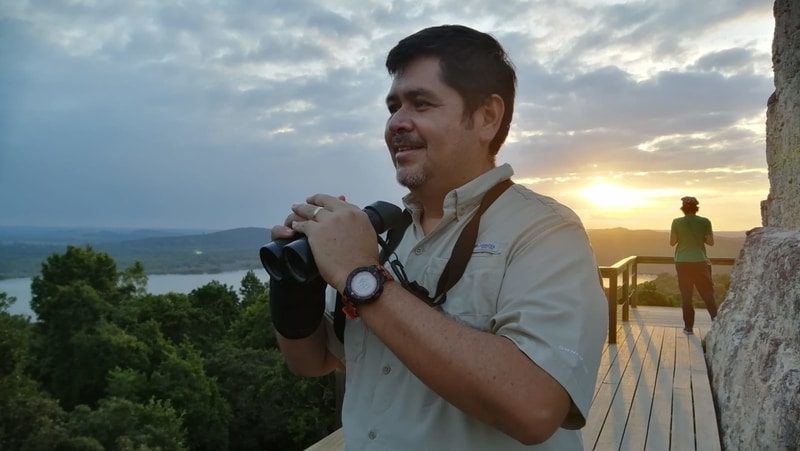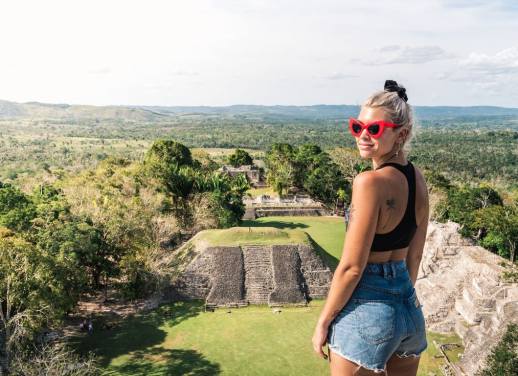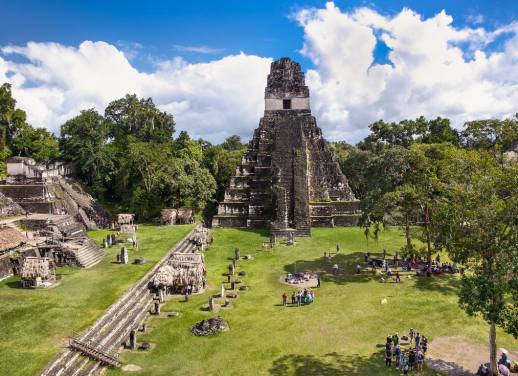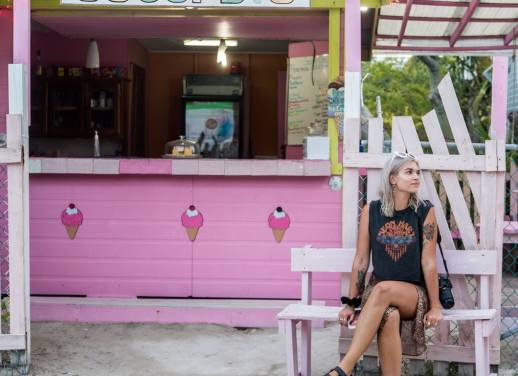Luis Felipe Guerra is Intrepid Deputy Operations Manager in Guatemala, but he’s also Maya, and a tour guide. As a child, he struggled to come to terms with his Indigenous heritage, facing racism on a regular basis. By discovering more about his history, and sharing it with travellers, he’s learned to take pride in his heritage. Now he wants young Guatemalans to do the same.
When my father was a child in Guatemala, he was not allowed to speak Mayan in the classroom. If he ever said a word in Mayan, my grandfather would have to pay a fine, and my father would be punished. He used to tell me about being made to kneel on corn kernels while holding a chair on his back, often for hours.
I come from a Mestizo background, which means I have mixed native and European ancestry. My father is Maya, of the Poqomam people, but my mother is European. I was born in the northern-most Petén region of Guatemala, and spent a lot of my childhood in one of our greatest Maya cities, Tikal, which is now a UNESCO World Heritage Site.
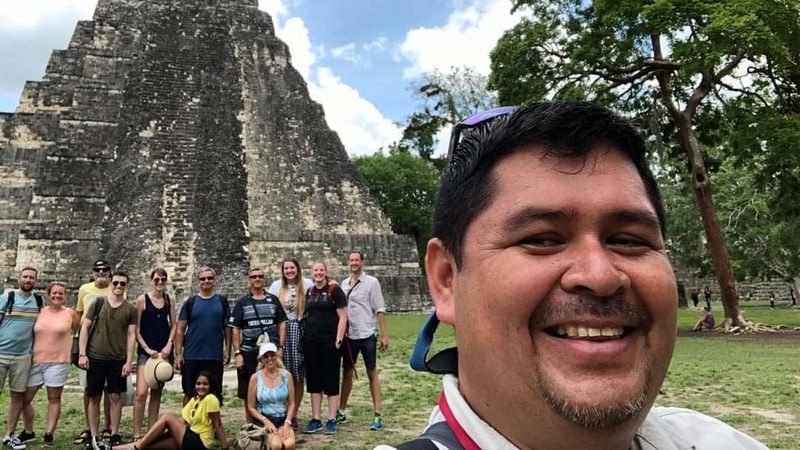
My father used to work for an airline that flew to Tikal, and eventually became a park ranger there. I remember my brothers and I bringing him lunch and playing amongst the ruins, watching the archaeologists do their work. This is where I first saw tour guides showing visitors around the site. As I watched these travellers, overwhelmed by the beauty of the pyramids, I believe that was the moment, without knowing, when my heart fell in love with tourism. I was hooked.
When I was growing up, Guatemala was a very racist country, and being Indigenous was not something to be proud of. Like my father, I was discriminated against in school. It took 36 years of civil war and hundreds of thousands of lives to turn things around. Guatemala had one of the longest running civil conflicts in South America, stretching from 1960 to 1996, and when it was over, one of the peace terms from the rebels was respect for all Indigenous people in the country. It was a horrible conflict, but because of that war, my children now learn Mayan at school! Kids can wear their traditional Maya dress, instead of the school uniform. It’s not perfect, and we still have a long way to go, but if you compare the culture now to my father’s generation, it’s been a total, 180-degree change.
For my own journey, tourism played a big part. I ended up at a high school that helped a lot of kids get into the travel industry. That’s where I met Mario, an archaeologist. He was my first direct contact with Maya history. Mario told our class about the equinox and how the Maya planned their agriculture by following astronomical events, by learning the rhythm of the seasons. I mentioned to him that I learned that from my grandfather, and that my grandfather was an Indian. Mario corrected me and said, “Luis, your Grandfather is not Indian. He is Mayan”.
Mario was the first one to make me feel proud of my Indigenous heritage, and he helped me become a tour guide. I started leading tours even before finishing high school! I fell in love with it, and I decided that’s what I wanted to do for the rest of my life. Even now, when I’m not working and I have a weekend to myself, I go and tour around the ruins. There’s a passion in me to share the history of my people, to share thousands of years of civilisation with anyone that wants to know about it.
As I watched these travellers, overwhelmed by the beauty of the pyramids, I believe that was the moment, without knowing, when my heart fell in love with tourism. I was hooked.
It’s all a learning process, even for tour guides. Once, when I was walking by a stone monument in Tikal, I saw a guide reading the hieroglyphics for a group. His name was Antonio, and he’s of the Kaqchikel Maya people. Until that day, I didn’t know anyone could read those hieroglyphics, let alone tour guides! So I waited for him to finish his lecture, then went up and asked him if he could share his knowledge with me. He smiled and said, “Of course!”
So Antonio started to teach me, and through him I got a spot at the University of Texas. From 2003 to 2009 I attended classes in Texas and learned how to read Maya hieroglyphics. This is what I love most about being a tour guide. Imagine stone carvings, made 1300 or 1700 years ago, and now I’m able to read those carvings; the words coming out of my mouth were written down by someone thousands of years ago. I can read their thoughts, and speak in the voice of the Maya. It’s a privilege to share this knowledge with travellers.
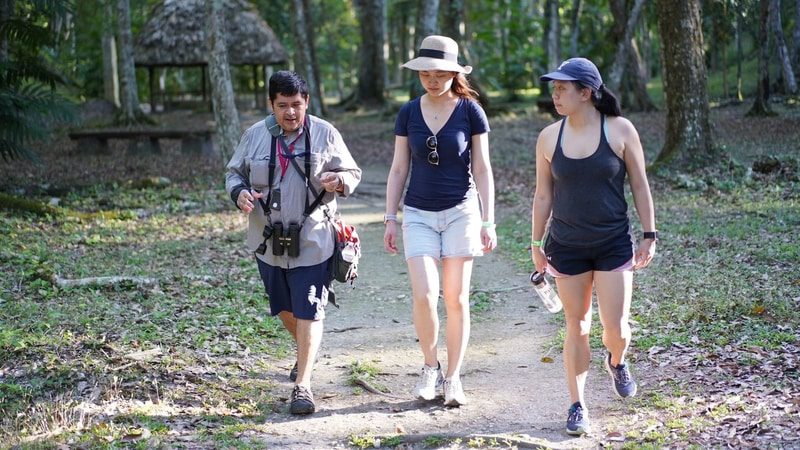
I expect tourism to become the number one industry in Guatemala over the next few years. Our government isn’t perfect, but they’ve slowly been protecting more historical sites, trying to encourage investment in tourism, and there are a lot of stories that are really encouraging. For the last few years, I’ve been working on Intrepid’s Indigenous Action Plan in Central America. It’s our roadmap for bringing Indigenous communities into tourism, and educating our customers about Indigenous history and culture. We want to get to the point where young Indigenous kids feel like travel is a legitimate career choice. We want to help them get into the industry with vocational training. Most of all, we want to offer people a different path.
I know one teenager, for example, Juanito, who lives in the highland communities and speaks at least eight different languages – French, Hebrew, Italian, Spanish and many Mayan dialects. He learns by meeting travellers and selling goods to them. Now this kid can leave his community and become an interpreter, or a tour guide. Stories like that are repeating all over the country. Boys and girls who become amazing leaders, and improve their quality of life by moving from agriculture into tourism.
It’s something that changed my own life. After being a park ranger, my father became a taxi driver, shuttling foreigners from Flores to Tikal. That taxi paid for my sister’s education, paid for my brothers’ and mine. My father only had a first-grade education, and my mother never got past the sixth grade, but that’s the beauty of tourism. Anyone can do it. There are no restrictions in your way. My family made their way into travel, and it changed our lives for the better.

